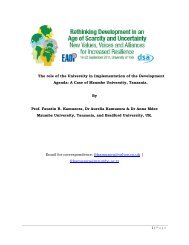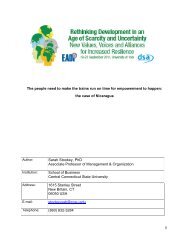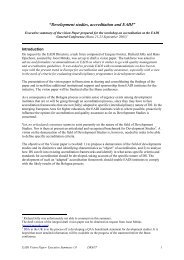Revenue Administration in Sub-Saharan Africa - International Tax ...
Revenue Administration in Sub-Saharan Africa - International Tax ...
Revenue Administration in Sub-Saharan Africa - International Tax ...
You also want an ePaper? Increase the reach of your titles
YUMPU automatically turns print PDFs into web optimized ePapers that Google loves.
Introduction<strong>Revenue</strong> collection is the pr<strong>in</strong>ciple responsibility of revenue bodies 78 and governments<strong>in</strong> SSA go to great lengths to monitor revenue performance, usually at the expense ofother key performance <strong>in</strong>dicators. Table 15 presents data on total revenue collectionsas a percentage of GDP and the contribution of major tax heads. Detailed revenue tablefor selected countries are also presented <strong>in</strong> Annex 3. Table 16 also summarizedrevenue collection data by collection department.Survey results (Tables 15, 16 and Annex 3)• Ten of the surveyed countries have tax-to-GDP ratios higher than 16.8%, whichis the average for low-<strong>in</strong>come and fragile SSA countries <strong>in</strong> 2008 (only Ethiopia,Rwanda, Sierra Leone, Tanzania and Uganda had lower tax-to-GDP ratios).• In 5 countries (Botswana, Kenya, Senegal, South <strong>Africa</strong>, and Zambia), thehighest proportion of revenue is collection from direct taxes.• In majority of the countries (Burundi, Ghana, Malawi, Mauritius, Rwanda,Tanzania and Uganda), <strong>in</strong>direct taxes contribute the highest proportion ofrevenue collection. Direct taxes account for the bulk of revenue collection <strong>in</strong> 6countries (Botswana, Ethiopia, Kenya, Senegal, South <strong>Africa</strong> and Zambia), whiletrade taxes make the greatest contribution to revenue collection <strong>in</strong> Ben<strong>in</strong> andSierra Leone.• Non-tax revenue accounts for a very small proportion of total revenuecollection (less than 2% <strong>in</strong> Uganda and Sierra Leone). 79• Data from 3 revenue bodies shows that customs departments collect between6-8% of GDP <strong>in</strong> revenue account<strong>in</strong>g for between 40-50% of total revenue.Key observationsA number of revenue bodies are implement<strong>in</strong>g vary<strong>in</strong>g tax adm<strong>in</strong>istration reforms. 80The survey shows that despite progress that is be<strong>in</strong>g made <strong>in</strong> implement<strong>in</strong>greforms, there are wide disparities <strong>in</strong> revenue collection across the surveyed countries,some of which appears to reflect differences <strong>in</strong> tax structures as well as efficiency andeffectiveness <strong>in</strong> tax adm<strong>in</strong>istration across revenue bodies. 81 Also, as already mentioned,customs departments play a significant part <strong>in</strong> revenue collection. Overall, it can bededuced that revenue bodies still face challenges. 8278 Other equally important responsibilities <strong>in</strong>clude implement<strong>in</strong>g tax policy objectives such as welfare programs,secur<strong>in</strong>g the border, trade facilitation, taxpayer service and production of statistics.79 Experience shows that cost of collection of these nuisance taxes/levies can be as high as 30 to 50%.80 Key reforms—based on best practice—that have taken place <strong>in</strong> a number of these countries <strong>in</strong>clude: (1) <strong>in</strong>tegration ofdomestic tax adm<strong>in</strong>istration, organized around key tax adm<strong>in</strong>istration functions; (2) establishment of a LTO, as a firststep <strong>in</strong> adopt<strong>in</strong>g a taxpayer segmentation approach; (3) implement<strong>in</strong>g systems and procedures based on selfassessment,<strong>in</strong>clud<strong>in</strong>g a taxpayer services function; (4) moderniz<strong>in</strong>g tax and customs laws and regulations, <strong>in</strong>clud<strong>in</strong>genact<strong>in</strong>g a law on tax procedures (Rwanda); and (5) automation of tax and customs operations. Significant resourceshave also been dedicated to tra<strong>in</strong><strong>in</strong>g and capacity build<strong>in</strong>g and <strong>in</strong>frastructure development.81 <strong>Revenue</strong> collection rema<strong>in</strong>s relatively low <strong>in</strong> majority of the surveyed countries (average government revenue(exclud<strong>in</strong>g grants) <strong>in</strong> non-resource-<strong>in</strong>tensive SSA countries was 22.9% <strong>in</strong> 2008).82 A key challenge is the need to <strong>in</strong>crease the tax-to-GDP ratio while at the same time reduc<strong>in</strong>g costs of collection.55





